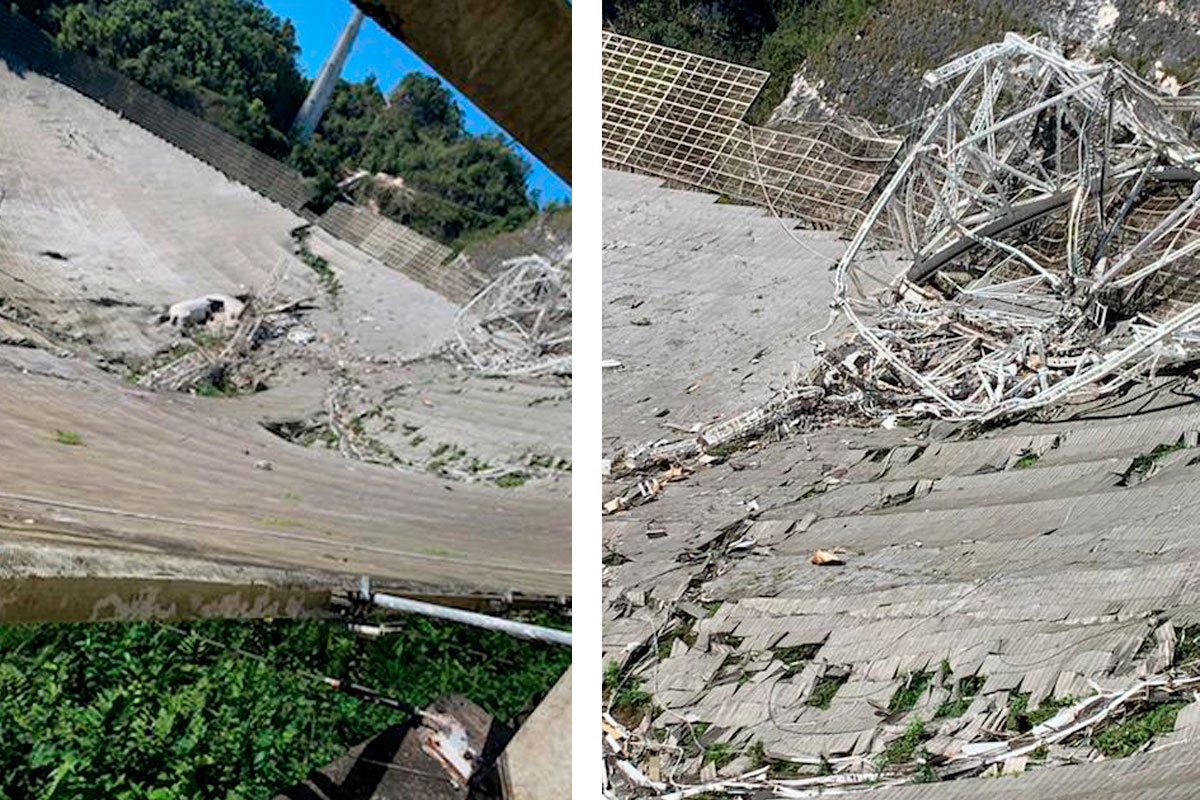The demise of the iconic radio telescope appears to have been filmed by chance.
This week collapsed the already battered Arecibo telescope. For those who can still understand it all difficult, the National Science Foundation video images have now been released that actually show how the telescope collapses.
The images
The video consists of two parts. The first part was made from a control room. From this room, a camera had a view of the 900-ton instrument platform that hung above the 305-meter-wide dish of the radio telescope and records how some of the cables holding the platform in place burst. The result is that the platform falls diagonally.
The second part of the movie was made by a drone that is used to monitor the cables of the Arecibo telescope. You can see how the drone visualises a tower with three cables that help to keep the instrument platform in place. The fourth cable was already taken down at the beginning of November. And while the drone displays the remaining cables, these too snap.
No surprise
That the iconic telescope in Puerto Rico collapsed earlier this week came as no surprise. In August, one of the cables that should hold the instrument platform in place came loose. The problems did not seem to be insurmountable and it was decided to repair the telescope. But shortly before work started, a second cable broke right in half in early November. An extensive investigation followed and it soon became clear that the telescope could just collapse in its current state. How to fix them was thought about, but time and again the risks for the construction workers turned out to be too great. And so they took the plunge on November 19: the telescope had to be dismantled.
The Arecibo telescope in better times. Here you can clearly see how the instrument platform is suspended above the 305 meter (!) Wide dish. Image: University of Central Florida.
–
Research and clean up
While experts were cautious about how to safely dismantle this clearly unstable telescope, it collapsed early this week. It has wreaked havoc, but fortunately there were no casualties. In the coming period, further research will be conducted into what exactly went wrong and how the remains of the radio telescope can be disposed of as safely as possible.

The platform has wreaked havoc. Image: University of Central Florida.
–
Memories
What remains besides the fragments of the telescope are of course the beautiful discoveries that the Arecibo radio telescope made possible. For example, astronomers with Arecibo have discovered the first exoplanets, demonstrated the existence of neutron stars, spotted the first repetitive fast radio flash and proved that the poles of Mercury have ice. To top it all off, the radio telescope played a central role in the search for alien life. For example, the telescope was used to detect possible extraterrestrial radio transmissions and was also used in 1974 to send a radio message to possible intelligent civilizations in the globular star cluster M13. After all, many will remember Arecibo from the movie Contact, in which Jodie Foster’s character uses the telescope to track down extraterrestrial life. Or else from the James Bond film GoldenEye.
Many hoped that the telescope would continue to claim a leading role in research into the universe and our place in it in the years to come. But that hope has now gone for good.
POPULAR ON SCIENTIAS.NL
Keep amazed ✨
Receive the most beautiful space photos and interesting popular science articles every Friday. Get the free Scientias Magazine together with 50,000 others.
–


